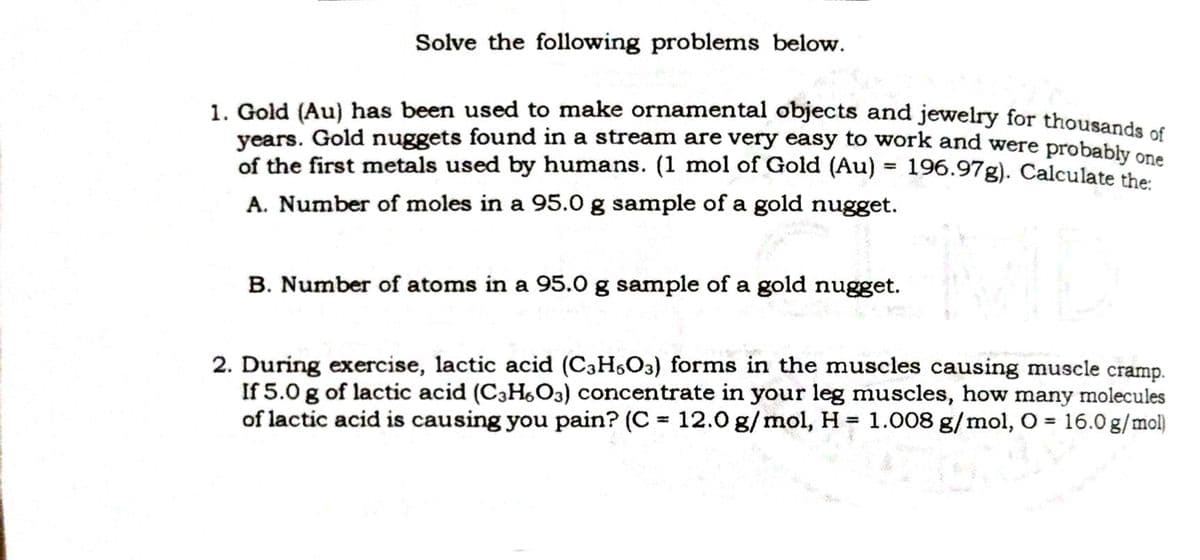Gold (Au) has been used to make ornamental objects and jewelry for thousande sf years. Gold nuggets found in a stream are very easy to work and were probably o of the first metals used by humans. (1 mol of Gold (Au) = 196.97g). Calculate the %3D A. Number of moles in a 95.0 g sample of a gold nugget. B. Number of atoms in a 95.0 g sample of a gold nugget.
Gold (Au) has been used to make ornamental objects and jewelry for thousande sf years. Gold nuggets found in a stream are very easy to work and were probably o of the first metals used by humans. (1 mol of Gold (Au) = 196.97g). Calculate the %3D A. Number of moles in a 95.0 g sample of a gold nugget. B. Number of atoms in a 95.0 g sample of a gold nugget.
Chemistry: Principles and Reactions
8th Edition
ISBN:9781305079373
Author:William L. Masterton, Cecile N. Hurley
Publisher:William L. Masterton, Cecile N. Hurley
Chapter3: Mass Relations In Chemistry; Stoichiometry
Section: Chapter Questions
Problem 1QAP: One chocolate chip used in making chocolate chip cookies has a mass of 0.324 g. (a) How many...
Related questions
Question
100%

Transcribed Image Text:Solve the following problems below.
1. Gold (Au} has been used to make ornamental objects and jewelry for thousande .
years. Gold nuggets found in a stream are very easy to work and were probably on
of the first metals used by humans. (1 mol of Gold (Au) = 196.97g). Calculate the
A. Number of moles in a 95.0 g sample of a gold nugget.
B. Number of atoms in a 95.0 g sample of a gold nugget.
2. During exercise, lactic acid (C3H,O3) forms in the muscles causing muscle cramp.
If 5.0 g of lactic acid (C3HO3) concentrate in your leg muscles, how many molecules
of lactic acid is causing you pain? (C = 12.0 g/mol, H = 1.008 g/mol, O = 16.0 g/mol)
Expert Solution
This question has been solved!
Explore an expertly crafted, step-by-step solution for a thorough understanding of key concepts.
This is a popular solution!
Trending now
This is a popular solution!
Step by step
Solved in 2 steps

Knowledge Booster
Learn more about
Need a deep-dive on the concept behind this application? Look no further. Learn more about this topic, chemistry and related others by exploring similar questions and additional content below.Recommended textbooks for you

Chemistry: Principles and Reactions
Chemistry
ISBN:
9781305079373
Author:
William L. Masterton, Cecile N. Hurley
Publisher:
Cengage Learning

Introductory Chemistry: A Foundation
Chemistry
ISBN:
9781337399425
Author:
Steven S. Zumdahl, Donald J. DeCoste
Publisher:
Cengage Learning

Chemistry: The Molecular Science
Chemistry
ISBN:
9781285199047
Author:
John W. Moore, Conrad L. Stanitski
Publisher:
Cengage Learning

Chemistry: Principles and Reactions
Chemistry
ISBN:
9781305079373
Author:
William L. Masterton, Cecile N. Hurley
Publisher:
Cengage Learning

Introductory Chemistry: A Foundation
Chemistry
ISBN:
9781337399425
Author:
Steven S. Zumdahl, Donald J. DeCoste
Publisher:
Cengage Learning

Chemistry: The Molecular Science
Chemistry
ISBN:
9781285199047
Author:
John W. Moore, Conrad L. Stanitski
Publisher:
Cengage Learning

Chemistry by OpenStax (2015-05-04)
Chemistry
ISBN:
9781938168390
Author:
Klaus Theopold, Richard H Langley, Paul Flowers, William R. Robinson, Mark Blaser
Publisher:
OpenStax

Chemistry: Matter and Change
Chemistry
ISBN:
9780078746376
Author:
Dinah Zike, Laurel Dingrando, Nicholas Hainen, Cheryl Wistrom
Publisher:
Glencoe/McGraw-Hill School Pub Co

Chemistry for Engineering Students
Chemistry
ISBN:
9781337398909
Author:
Lawrence S. Brown, Tom Holme
Publisher:
Cengage Learning